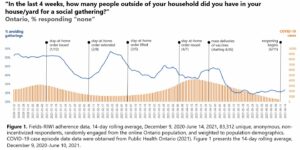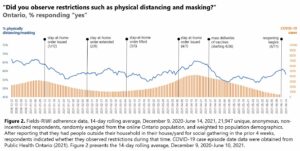By Rikki H. Sargent (RIWI), Danielle Goldfarb (RIWI), Tianshuo Yang (RIWI), Neil Seeman (RIWI and IHPME, University of Toronto), Catherine Barker (RIWI), Justin Trent (Fields Institute), Jordana Feldman (Fields Institute) and V. Kumar Murty (Fields Institute)
Lush foliage in full bloom, hot days and the whirrs and chirps of small creatures used to signify Ontario’s return to life each summer. This year, nearly 18 months into one of the longest continual lockdowns in the world, these familiar signs took on a slightly modified tenor.
In addition to the untamed sprawl of plant life, city sidewalks teemed with the managed sprawl of patio diners spilling into the road. Businesses forced to close their doors for the bulk of the COVID-19 pandemic welcomed back customers with the excitement of camp counsellors reunited with their campers. Millions of Ontarians saw loved ones for the first time since last fall.
There was a sense of joy in the air. But as the province continued its phased loosening of restrictions, a number of public health challenges threatened to temper it with very real dangers. The circulation of variants of concern – particularly the highly contagious Delta variant, the percentage of people who were yet to be vaccinated and the potential influx of international visitors due to relaxed border restrictions meant that we were not out of the woods yet.
As of early August, Ontario, along with the other provinces, found itself in a fourth wave. Ontarians need to continue following public health measures (PHMs) in order to prevent another major spike in cases. This means wearing a proper-fitting mask, maintaining physical distancing when necessary, and limiting indoor gatherings with people outside their household. The science is sound and the results of following these guidelines are clear. Vaccines will have to be supplemented with PHMs if we are to keep the numbers under control.
The Fields Institute for Research in Mathematical Sciences has spent the duration of the pandemic undertaking research relating to COVID-19. The Canadian Institutes for Health Research (CIHR)-funded Mathematical Modelling of COVID-19 Task Force brought together Canadian mathematics institutes, national and international co-investigators, collaborators and researchers, to mobilize a network of infectious disease modellers to assess transmission risk, predict outbreak trajectories and evaluate the effectiveness of COVID-19 countermeasures.
Models produced by the Task Force have provided important input to help decisionmakers in public health and government grapple with difficult problems such as when to shut down indoor non-essential spaces, curb public gatherings and how to manage the closure and reopening of schools and border crossings. These models use advanced mathematics to predict the number of infections, hospitalizations and deaths that could result from a range of scenarios.
Knowing how many people adhere to public health measures improves the accuracy of this mathematical modelling, further increasing its reliability as a tool for public health policy decisions. The Fields-RIWI survey offers this critical insight.
The Fields Institute has used RIWI’s survey technology to understand, in real-time and on a continuous basis, the degree to which Ontarians have adopted and maintained public health directives during the pandemic. This research measures self-reported adherence with physical distancing restrictions and public health policies, including physical distancing and mask wearing, from December 2020 to June 2021 and ongoing (see Figures 1-2).
Looking back at self-reported adherence to public health directives over a duration of seven months, we can see clear inconsistencies in PHM uptake* which have not correlated to safety recommendations or even legal mandates during this period. For health leaders and policymakers to implement the most effective policies moving forward, it is critical to understand public attitudes, decision making and real-time responses to the changing COVID-19 landscape. Here is what we found and what we recommend.
* An important nuance to these results: Respondents who reported visiting another household did not necessarily fail to adhere to public health directives, particularly if they remained outdoors. Throughout the province’s pandemic response, outdoor visits have at various times been encouraged, discouraged, limited or banned in select regions only.


The survey findings show that Ontarians’ PHM uptake is often at odds with public health guidance. The numbers below reflect results that have been weighted to population demographics. Here we highlight some of these trends:
- In December 2020, before the January spike in cases, around half (47%) of respondents reported having visitors to their home for social gatherings (see Figure 1), and only two thirds (66%) of those adhered to masking/distancing directives (see Figure 2).
- After the January 2021 stay-at-home order, there was a noted decline in uptake. Self-reported social gatherings in a house/yard increased and there was a decline in adherence to physical distancing/masking among those who attended those social gatherings.
- With the stay-at-home order extension in February, more Ontarians reported following physical distancing guidelines, peaking with 67% of respondents on February 16th having no visitors to their homes.
- Between March and April 2021, less than half (41%) of respondents reported avoiding social gatherings in their home/yard, even when a new stay-at-home order was enacted in early April.
- Since the start of March and through mid-June, a large proportion (41%) of respondents did not follow physical distancing/masking guidelines when gathering with others in their home/yard.
- The data show a steep and continued drop in physical distancing adherence following the Phase 2 mass vaccination program, especially in relation to social gatherings at home (in June, only 31% of respondents reported avoiding these social gatherings). We would expect a continued decline as Ontario continues to reopen/lift restrictions.
The pandemic has lasted far longer than most imagined, and with the more transmissible Delta variant spreading in the population – especially among the unvaccinated – convincing millions of Ontarians to continue cooperating with public health measures will remain a challenge. We know there are still some Ontarians who, despite the science, remain firmly resistant to following the guidelines. Even within the population that has diligently followed public health measures from the start, there are legitimate signs of fatigue; people would understandably rather swap mathematical models for restaurant menus.
Minimizing the impact of the fourth wave will require all of us to act on lessons learned from previous efforts and lessons from elsewhere. This survey provides valuable real-time insight into adherence around public health guidelines, and with this information comes the opportunity to better support people.
The survey shows that gaps in PHM uptake need to be properly addressed and we need to find more effective ways of communicating the importance of maintaining these safety measures.
Trust in public health authorities and adherence to public health measures are critical factors, especially with the possibility of endemic COVID. As the pandemic continues to evolve, the Fields Institute and RIWI will also continue to assess the response of the population to public health restrictions.
A Note on RIWI Methodology
To get a reliable measure of sentiment on this issue and others, the Fields Institute used RIWI’s Random Domain Intercept Technology to hear from random cohorts of the Ontario Web-using population on a continuous basis since the start of the COVID-19 pandemic. RIWI collects data using patented, machine-learning technology in order to reach the broadest possible set of potential survey respondents continuously, drawing in populations otherwise not included in data collection. Anyone using the Web in Ontario could be randomly exposed to a RIWI survey. This is unlike typical surveys that draw on habitual, incentivized survey respondents. Also unlike typical surveys, RIWI surveys are anonymous, continuous, and do not collect personally identifiable information. RIWI collects information in 229 countries and territories and in over 80 languages. RIWI leverages its technology to conduct scientific surveys and impactful digital campaigns. Visit RIWI at https://riwi.com.
Image Credit: Tim Mossholder licensed under Unsplash
